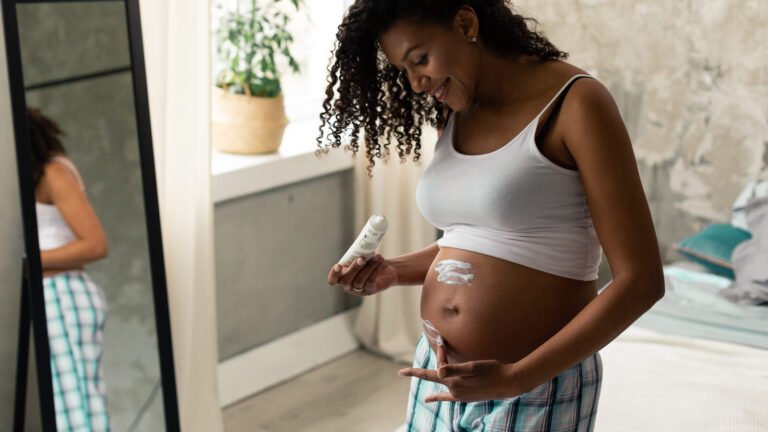Atopic dermatitis, commonly known as eczema, is an itchy and inflamed skin condition that can cause red or darker patches during a flare-up. Symptoms can be mild, moderate or severe and may come and go. If you’re one of the many people who are pregnant and dealing with this itchy, inflamed skin problem, you’re not alone. Atopic dermatitis is common in pregnancy. More than half of people with eczema develop symptoms for the first time during their pregnancy. Hormonal changes in pregnancy can make symptoms worse.
There are many ways that healthcare providers can treat your atopic dermatitis during pregnancy. Treatment can be topical (used on the skin) such as moisturizers and creams, or systemic (medicine taken by mouth or injection). Information on specific medications can be found in our newsletters at by contacting a MotherToBaby specialist at 866.626.6847.
In general, the first line of treatment in pregnancy is topical due to the route of exposure. The developing baby is exposed to things in a pregnant woman’s blood. When you take a medicine by mouth or swallow something, we know that it is very likely to enter the bloodstream, where it can then cross the placenta and reach the baby. With most topical products, the skin serves as a good barrier, so it is not expected that a significant amount of the product could enter the pregnant woman’s bloodstream, where it can then reach the baby. This is especially true when the topical product is used on small areas of the body, is used infrequently, or is used on healthy (unbroken) skin.
If topical treatment doesn’t work for you, fear not, there may be a glimmer of hope – phototherapy.
Understanding Light Therapy:
Phototherapy, also known as phototherapy, is a treatment option for atopic dermatitis that involves exposing the skin to ultraviolet (UV) light under controlled conditions. There are several types of phototherapy including: narrow band (NBUVB), broad band (BBUVB), UVA, UVA1, full spectrum light, seawater bath plus UVB (bath therapy), psoralen plus UVA (PUVA) and other forms of phototherapy. UV light is the same light that comes from the sun and is not radiation. This treatment aims to reduce inflammation and itching, ultimately improving the overall condition of the skin.
Light therapy during pregnancy:
While there is limited research on light therapy during pregnancy, it is not expected to increase the chance of pregnancy complications. Most types of light are not expected to be absorbed by the skin and reach the developing baby. However, while NBUVB and BBUVB phototherapy can be used during pregnancy, they may decrease folate levels. Folic acid is very important for the development of the baby especially in the first trimester of pregnancy. Be sure to talk to your healthcare provider about taking folic acid supplements and monitoring your folate levels if you need to have phototherapy during the first trimester. You may find our fact sheet on folic acid useful here: In addition, psoralen and ultraviolet A (PUVA) therapy should be avoided during pregnancy due to an increased chance of low birth weight (weighing less than 5 kg, 8 ounces [2500 grams] at birth).
In order to learn more about how atopic dermatitis and light therapy can affect pregnancy, MotherToBaby is currently enrolling people who are pregnant in the Eczema & Pregnancy Study. You can impact the health of future families today by participating in the study. Learn more about the study here:
Skin protection:
Your healthcare provider may recommend that you use sunscreen for additional skin protection after phototherapy. Sunscreen ingredients such as avobenzone, homosalate, octisalate, and octocrylene can be absorbed through the skin in small amounts with regular use, especially if used over large areas of the body. However, there is no proven increased risk for pregnancy from using these ingredients. Mineral sunscreens contain zinc or titanium which are natural blocking agents and remain on top of the skin. This means they are not absorbed through the skin and are not expected to reach the developing baby. More information is available on our blog:
As with any medical treatment during pregnancy, it is essential to weigh the potential risks and benefits with your healthcare provider.
Things to consider:
Before starting light therapy, there are a few things to consider:
1. Consult your healthcare provider: Always consult your healthcare provider before starting any new treatment, especially during pregnancy. Your healthcare provider can help you assess the potential risks and determine whether and what type of light therapy is right for you.
2. Alternative treatments: If phototherapy isn’t right for you during pregnancy, don’t worry! There may be other treatment options available that can help manage your symptoms. Information on specific medications can be found in our newsletters at by contacting a MotherToBaby specialist at 866.626.6847.
3. Consider joining the MotherToBaby Eczema & Pregnancy Study: Interested in joining our community of expectant parents sharing their pregnancy journey with our study team? If you would like more information, visit or call 877-311-8972.
In conclusion:
Atopic dermatitis can be difficult to manage, especially during pregnancy. However, phototherapy offers a ray of hope for many people who are pregnant and struggling with this skin condition. Remember to always consult your healthcare provider to determine the best course of action for you and your baby. You got this!
